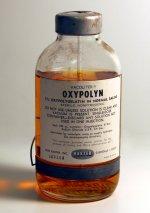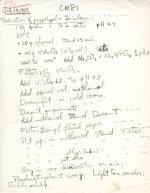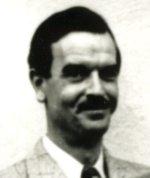
An original container of 5% Oxypolygelatin in normal saline. 1940s.
During World War II, Linus Pauling, along with Dan H. Campbell and Joseph B. Koepfli, created a blood plasma substitute which they dubbed “oxypolygelatin.” This new compound seemed to be an acceptable substitute for human blood, but needed more testing to be approved by the Plasma Substitute Committee. Unfortunately when Pauling asked for additional funds to carry out more testing in 1945, he was denied by the Committee on Medical Research, which had been funding research up until that point.
By the time Pauling received more funding the war had almost come to a close, and it ended before oxypolygelatin got off the ground as an acceptable blood substitute. Likewise, the need for artificial blood was less pressing after the conclusion of the war. More information on the creation and manufacture of oxypolygelatin can be found in our blog posts “Blood and War: The Development of Oxypolygelatin, Part 1,” and “Pauling on the Homefront: The Development of Oxypolygelatin, Part 2.” Today’s post will focus on the patenting, ownership and uses of oxypolygelatin after World War II.
Pauling seemingly gave up on the project after 1946, mostly because widespread blood drives organized by the Red Cross and other organizations lessened the demand for artificial blood. In 1946 Pauling, Campbell and Koepfli decided to file for a patent on oxypolygelatin and its manufacturing process, which they then transferred to the California Institute Research Foundation with the stipulation that one of the inventors would be consulted before entering into any license agreement. They also noted that the Institute should collect reasonable royalties for the use of the invention, but only so much as was needed to protect the integrity of the invention.
The “Blood Substitute and Method of Manufacture” patent was filed December 4, 1946, and the Trustees of the Institute agreed to take on ownership of oxypolygelatin and the patent application in early 1947.

Notes by Linus Pauling on a method for producing oxypolygelatin. July 23, 1943.
Although it would appear that Pauling gave up on the oxypolygelatin project with the transfer of ownership, he still pushed for its manufacture years later. In October 1951, he wrote to Dr. I. S. Ravdin of the Department of Surgery at the University of Pennsylvania Medical School to inform him that oxypolygelatin was not being considered seriously enough by the medical world as a blood substitute.
Pauling insisted, “…that it is my own opinion that Oxypolygelatin is superior to any other plasma extender now known.” He likewise noted that it was the only plasma extender to which the government possessed an irrevocable, royalty-free license, so he could not understand why it was not being stockpiled and utilized.
As far as Pauling knew, only Don Baxter, Inc., of Glendale, California, was manufacturing oxypolygelatin. At this point the rights to oxypolygelatin were owned by the California Institute Research Foundation, not Pauling, and the Institute was not authorized to make a profit from it. Consequently, Pauling’s insistence on the production and usage of his invention can only be explained by a concern for humanity, coupled perhaps with an urge to see the compound succeed on a grander scale.
Later in 1951, Pauling continued to push for the usage of his invention, arguing in a February letter to Dr. E.C. Kleiderer that oxypolygelatin was superior to the plasma substitutes periston and dextran. In Pauling’s opinion “the fate of periston and dextran in the human body is uncertain…these substances may produce serious injuries to the organs, sometime after their injection.”
Oxypolygelatin, on the other hand, was rapidly hydrolyzed into the bloodstream and would not cause long-term damage. It was also a liquid at room temperature, unlike other gelatins, and was sterilized with hydrogen peroxide to kill any pyrogens (fever-inducing substances) while many other gelatin preparations failed because of pyrogenicity. One of the only problems with oxypolygelatin was that the chemical action of glyoxal and hydrogen peroxide could potentially produce undesirable materials, but the matter could be cleared up with further investigation.
It appears that Pauling’s interactions with Ravdin and Kleiderer did not result in the mass manufacture or marketing success of oxypolygelatin, but this did not deter Pauling from pursuing the matter many years later. In 1974, after visiting Dr. Ma Hai-teh in Peking, China, he sent Ma his published paper on oxypolygelatin, and discussed the possible production of the substance in China. He wrote to Ma, “I hope that you can interest the biochemists and pharmacologists in investigating Oxypolygelatin. I may point out that no special apparatus or equipment is needed.”
In reply, Ma expressed interest in oxypolygelatin and said that he had passed Pauling’s paper on to a group of biochemists, but that he was personally more interested in Pauling’s work on vitamin C. The rest of their correspondence focused primarily on the benefits of vitamin C, especially in the treatment of psoriasis.
In a 1991 interview with Thomas Hager, author of the Pauling biography Force of Nature, Pauling claimed, “I patented, with a couple of other people in the laboratory, the oxypolygelatin. I don’t remember when I had the idea of making oxypolygelatin. Perhaps in 1940 or thereabouts.” He added that it was not approved by the Plasma Substitute Committee, so it was not usable for humans, but was manufactured instead for veterinary use.
At the time of the interview, Pauling believed that oxypolygelatin was still being manufactured in some places, but was unsure of the details since there were many rumors floating around. According to him, the Committee on Plasma Substitutes did not approve his oxypolygelatin because it wasn’t homogenous; meaning that, on the molecular level, it included a range of weights. Pauling, however, believed that the range in molecular weights should not matter, since naturally occurring blood plasma includes serum albumin and serum globulin, whose molecular weights fall in a wide range anyway.

Joseph Koepfli
In 1992 Hager also interviewed Joseph Koepfli, one of the co-inventors of oxypolygelatin. Koepfli claimed that oxypolygelatin was at one time used by motorcycle officers around L.A. because they were the first to the scene of accidents. He also remembered that, in the early 1980s, Pauling had told him that oxypolygelatin was used for years in North Korea, but that no one was ever paid any royalties.
These and a few other rumors about oxypolygelatin circulated, but evaluating their worth is virtually impossible due to the secrecy surrounding wartime scientific work, as well as the scarcity and ambiguity of the surviving documentation. Judging from Pauling’s opinions though, what can be said is that perhaps if it had been pursued more vigorously, oxypolygelatin could have benefited the war effort and proven successful on a commercial level.
